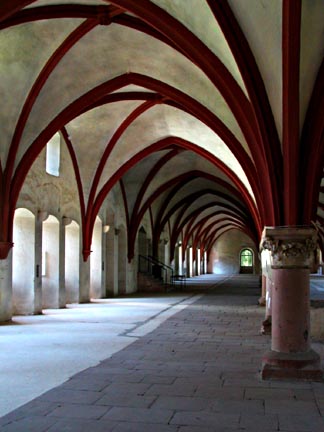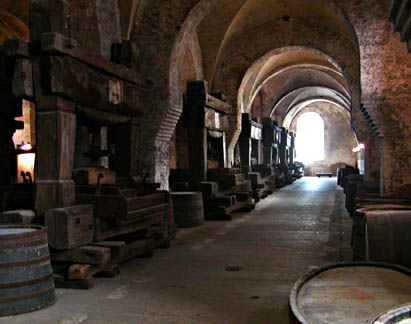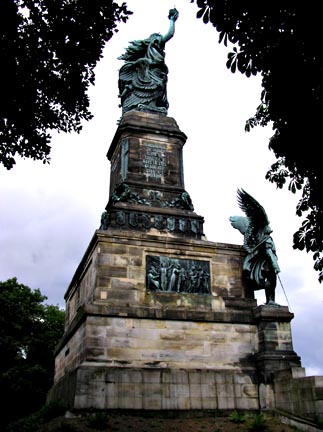 |
|||||
|
One of the interesting stops in the Rheingau (other than the vintners), is the Cloister Eberbach near the town of Eltville. We visited here in the fall of 2003 on a day trip from Idstein. The cloister is a typical example of a completely preserved Cistercian monastery. At left is the Cloister church, originally built in the mid-1100’s, but updated through the years. The interior is now completely stark, after the rich Baroque interior was removed upon the dissolution of the monastery. Today it is predominantly used for classical concerts. The Monk’s Dormitory (right) was originally built between 1250 and 1270 then later expanded in the middle of the 14th century.
The tradition of wine growing continues until today and many varieties of wine are sold at the site. One part of the old monastery serves as a wine tasting area and shop, where of course we had t The lay brother’s dining hall is now the home to a variety of preserved wine presses (below, right). These presses are huge, manual devises designed to press out the juice of the grapes for making into wine. Many of them still retain the carved date indicating when it was made. The oldest one we found was from 1668. Although the room was never used to actually press the grapes, it serves as a wonderful museum today. In the spring of 2004, we returned again to the Rheingau area, this time on a drive with our friend and host, Erdmann Scheibe, from Idstein. He was driving us around to show us the area and brought us up to the hilltop above the Rheingau. From here, there is a fantastic view of the Rheingau (photo below).
This monument was the basis for modern tourism and in order to do justice to the number of visitors who wanted to see the monument, a rack railway was built in 1884 from the riverside to the hilltop. The rack railway was replaced in 1954 with a cable car. The 2-person cars glide visitors over the vineyards to the monument. |
|||||
|
If you find typographical errors or have any other problems when looking at the site please contact the Webmaster describing the problem and the page involved. |
|||||
|
Copyright © 2000-2009 Jim Seavey and Verna Norris All Rights Reserved |
|||||
 The Rheingau is the area around the Rhein (Rhine) river (hence its name) and as you might expect, it is covered with vineyards. As far as the eye can see, vineyards cover the landscape. But all that area is needed to produce the wonderful bounty of Rhine wine.
The Rheingau is the area around the Rhein (Rhine) river (hence its name) and as you might expect, it is covered with vineyards. As far as the eye can see, vineyards cover the landscape. But all that area is needed to produce the wonderful bounty of Rhine wine. Most of the structures were built between the 12th and 14th c e n t u r i e s a nd today the monastery is considered to be the most important architectural edifice of the Middle Ages in the German state of Hesse. There are also a few Baroque-style structures added to the Romanesque and early Gothic architecture.
Most of the structures were built between the 12th and 14th c e n t u r i e s a nd today the monastery is considered to be the most important architectural edifice of the Middle Ages in the German state of Hesse. There are also a few Baroque-style structures added to the Romanesque and early Gothic architecture.

 o buy some wine!
o buy some wine!
 The hilltop is also home to the Neiderwald Monument with its statue of “Germania.” The statue was built from 1877 to 1883 to commemorate the end of the Franco-German war and the re-establishment of the German Empire. The bronze statues are reportedly made from the the French cannons captured by the Germans during the war.
The hilltop is also home to the Neiderwald Monument with its statue of “Germania.” The statue was built from 1877 to 1883 to commemorate the end of the Franco-German war and the re-establishment of the German Empire. The bronze statues are reportedly made from the the French cannons captured by the Germans during the war.